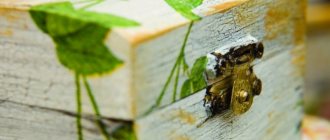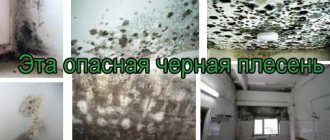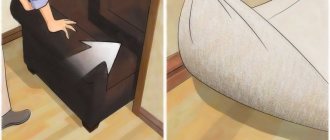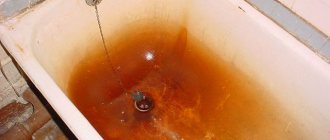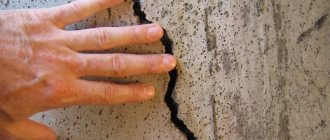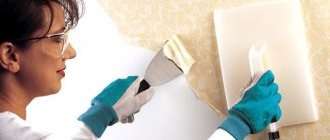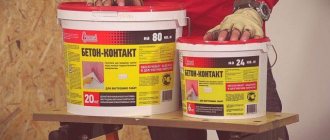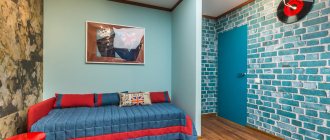| Tweet |
Are you the happy owner of a large happy family and an army of pets, or at least one baby and a small cat? This means that you know that stains tend to appear everywhere - not only on horizontal, but also on vertical surfaces. More precisely, on wallpapered or painted walls. And if it’s easier to remove them from the floor, then with wallpaper and paint things are much worse. Here you need to know exactly how and what to clean with in order to achieve the desired results, and not just another home renovation.
Ammonia for oil and alkyd enamel
On such a surface there is a durable and dense film that is resistant not only to moisture and water, but also to mechanical stress. Therefore, such walls can be safely washed, but it is not recommended to use soap, soda or washing powders for this.
An excellent remedy for oil and alkyd enamel is an aqueous solution of ammonia, which can be prepared at the rate of 1 tablespoon per 1 liter of warm water.
The process of washing walls is simple - you need to soak a sponge in a solution of ammonia and use it to rub the stained area.
If ammonia does not help, then you can try fresh potatoes, the tuber of which needs to be grated on a fine grater, after which the gruel is applied to a sponge and rubbed over the dirty area.
Getting rid of old whitewash
Old whitewash can be removed in two ways - dry and wet.
Dry method of whitewash removal
You will need:
- respirator;
- Sander.
A lot of dust during work is a significant disadvantage of this method. All furniture must be removed from the room or wrapped in protective film. The advantage is that the sanding machine will quickly clean the walls of whitewash without damaging them.
Wet method
Tools needed to remove whitewash:
- putty knife;
- bucket with water;
- sponge;
- brush.
In this case, the old whitewash will need to be washed away by generously wetting the walls with water using a sponge. The whitewash that has become pliable is removed with a spatula, and the remaining areas are treated with a brush and washed off with water to the base.
- Beating off old plaster with a spatula or hammer. If it doesn’t come off well, use a grinder, a hammer drill, or a special machine with abrasive discs. Before this, the wall should be moistened with water to reduce dust.
The appearance of soot on the walls is provoked by many factors, such as excessive flame in the fireplace, stove, boiler or fire. In any case, this phenomenon must be eliminated. Since soot spoils the appearance of the walls and reduces the aesthetic appeal of the room. We will learn further about how to remove soot and how to clean soot.
How to clean soot after a fire with your own hands
After a fire of any complexity, the walls, ceiling and objects in the room are covered with soot and soot. There are several options for products suitable for removing soot from walls.
In order to determine the most effective method of getting rid of soot, it is necessary to study its structure. First of all, soot is a sticky mass that contains remnants of materials that burned during a fire. Therefore, depending on the type of these materials, both sticky, greasy and dry soot are emitted. To get rid of soot, aggressive methods are most often used.
Before you start working on cleaning the walls from soot, follow these steps:
- inspect the walls for the nature and level of soot on their surface;
- remove materials that cannot be restored;
- determine the most effective way to clean the walls, in relation to the type of soot that is present on them;
- clean the walls from soot using available materials;
- eliminate the burning smell;
- ventilate the room.
Before you start cleaning, check the room, as the smell left after a fire has a negative impact on human health. When cleaning walls from soot, use rubber gloves and a mask. It is advisable to cover your hair with a headscarf, wear old clothes that you don’t mind getting dirty with soot and then throwing away. Please note that the entire body should be covered with clothing, as it will be quite difficult to wash off the soot.
Before removing soot, prepare materials in the form of:
- plastic bowl;
- high-power vacuum cleaner;
- a large number of unnecessary rags;
- special chemical sponges that are sold in hardware stores;
- broom;
- brushes with stiff bristles;
- spatula and brushes;
- roller and container for it.
In addition, it is necessary to select a number of chemicals that will help get rid of soot on the walls.
How to clean soot from walls: step-by-step work
The first stage of work in a room after a fire is getting rid of unnecessary garbage and burnt things. If you have charred furniture, remove it from the room. Surviving items in the form of carpets, paths, curtains must be ventilated outside to remove the unpleasant burning smell. If you cannot get rid of the smell, then thoroughly wash the curtains with powder and rinse aid, and to clean carpets, use chemicals or take them to a dry cleaner.
Unfortunately, it will not be possible to remove the smell from unaffected books, so either throw them away or place them in a room where you do not visit often so that they do not spread the burning smell.
If the wallpaper in the room is burnt, then it is necessary to remove it from the walls and take it outside, the same should be done with the burnt floor covering, plastic objects, baseboards, etc.
After getting rid of all the items in the room, move on to the second step, which is to perform dry cleaning. If the floor in the room is not damaged, then before you start cleaning the walls, lay a film on it and secure it with tape. Next you should do the following:
- remove wallpaper or paint on the walls;
- Using a vacuum cleaner, clean the walls from burning and soot, thoroughly treat the cracks;
- to remove dirt, use a brush with stiff bristles or a broom; try to sweep away soot from the wall, but do not rub it into the surface;
- for further cleaning, use special chemical sponges, impregnated with a composition that helps in washing soot from the walls;
- do the work starting from the bottom, gradually moving up the wall;
- After the upper part of the sponge is clogged, it is removed.
After dry cleaning, start cleaning the area. To do this, you will need to prepare clean water, rags and containers in the form of buckets or basins. As a detergent, use regular dish gel or baking soda with hot water. Do not press the rag while wiping off the soot; lightly wipe the surface with it. As soon as the water turns dark, replace it with new water. Wash the walls several times; if soot still remains on them, use a stiff brush soaked in dishwashing gel to remove it.
Please note that it is prohibited to carry out wet cleaning immediately after a fire. Initially, it is necessary to remove most of the soot with a vacuum cleaner and dry rags, only after that the soot is removed with water. In order to neutralize the remaining soot on the wall, it is recommended to apply a sealant to it. Next, the walls are covered with soil. To further purify the air from unpleasant odors, special chemical neutralizers are used.
In addition, air purification is carried out by special cleaning companies using ozonizers. In order not to buy this equipment, rent it or hire specialists who will clean the air in the room professionally and quickly.
It is with the help of ozone that it is possible to very quickly clean the room from the smell of burning. This substance has excellent disinfectant characteristics. To use this material, it is enough to turn on the equipment for a certain time until the odor is completely removed from the room.
If it is not possible to purchase an ozonizer, put water on the stove, which should boil for about 6-8 hours. Soak clean rags in vinegar and place them around the house. Change rags periodically, as they quickly absorb unpleasant odors. If you have a bathroom, turn on the hot water and open the door to allow steam to enter the air and clean it. It is possible to make your own special solution that will help remove the burning smell from the room. To do this, connect the following components to each other:
- baking soda - forty grams;
- hydrochloric acid - the same amount;
- ammonia - forty grams;
- any container made of tempered glass.
To prepare the solution, combine ammonia and soda. Next, add acid to the resulting composition. The reaction will produce white smoke called ammonium chloride. It is he who is able to remove the smell of burning in the room. Leave the mixture in the room for 24 hours, close all doors and windows tightly and leave the house. Then ventilate the room for several hours or days, depending on the degree of burning. After that, start doing renovations indoors. There will be no burning smell in the room.
How to clean the walls of copolis in a bathhouse
In most cases, after several years of using the bathhouse, soot appears on its walls or ceiling. Since natural wood is most often used to build a bathhouse, it absorbs not only moisture, but also soot particles, losing its former attractiveness.
There are several methods for cleaning walls from soot, we suggest you familiarize yourself with them:
1. Mechanical devices.
In this case, to remove soot, use a well-sharpened scraper or any sharp object capable of scraping soot from the wall. However, this cleaning method will require a lot of time and physical effort.
After each heating of the bathhouse, it is necessary to maintain cleanliness and clean the walls of soot with a brush. These methods are labor-intensive and ineffective, since the wood is covered with knots, removing soot from which is problematic.
To simplify the process, use a sanding machine, with which the entire process of cleaning the walls will take a minimum of time. After sanding the wood, use a cloth and soapy water to remove any dust on the walls.
2. Clean the wall of soot using traditional methods.
In order to avoid excessive accumulation of soot on the wall, after each firebox, wipe it with a wet cloth and soapy water. However, there is not always free time to follow this recommendation, so if the walls are still smoked, use available means to clean them.
3. Chemical compositions.
The most effective way to remove soot is to use special compounds in the form of a remover. After applying this substance to the wall, you must wait a certain time specified in the instructions and wash off the composition along with the soot from the walls. These substances contain alkaline substances that remove soot and soot from the wall.
How to clean soot from metal
If fuel burns improperly in a stove or boiler, soot settles not only on their surface, but also on things surrounding the heating device. If the soot has recently formed, a damp cloth is sufficient to remove it. However, removing long-term soot is not so easy; special efforts will have to be made.
To remove soot from a steel surface, use a composition in the form of river sand or broken brick. However, with the help of these abrasives the metal surface is destroyed. The use of a brush also implies the presence of plaque and stains on the walls, spoiling the appearance of metal objects.
The most effective way to remove soot from metal is with chemicals. Special removers are applied to the surface and after a few minutes, completely clean it of soot without damaging the metal.
Using steel cookware in contact with an open flame also causes soot to appear on it. In this case, river sand or ordinary brushes are also used to remove soot.
It is recommended to remove soot immediately after it appears; in this case, it will not require much effort to clean the dishes from soot. Otherwise, use citric acid, ash or coals, river sand, a steel brush or Coca-Cola, which works very well at removing soot.
How to clean soot from a ceiling
- special cleaning compounds;
- old rags;
- paint solvent;
- primers;
- various types of brushes with stiff bristles;
- special sponges with impregnation;
- a broom and items that can be used to clean the room.
Before you start cleaning the ceiling from soot, put on unnecessary clothing and protect your eyes and hair from black dust.
Cleaning the ceiling from soot involves performing the following actions:
1. Install paper or film on the floor. Otherwise, fine soot will fall into the cracks on the floor and remain there.
2. Using a broom or vacuum cleaner, clean the ceiling from soot deposits. Don't rub it in.
3. Using chemical sponges, clean the soot from the ceiling. Change sponges periodically as they become dirty.
4. Remove newspapers from the floor and cover it with film, since dirty water will drip onto the floor while washing the ceiling.
5. After the rag turns black, it needs to be replaced with a new one.
6. Wait for the ceiling to dry and if you are not satisfied with the result, repeat the procedure again. Wash the ceiling until there are no traces of soot on it.
7. To remove small stains on the ceiling, use white spirit solvent. To apply it, take a cotton swab.
8. After the walls have completely dried, coat them with a deep penetration primer.
Methods for cleaning brick from soot
Most often, fireplaces made of this material are susceptible to the appearance of soot on bricks. Agree that a fireplace covered with soot looks completely unpresentable. Therefore, there are a number of methods to combat soot on brick surfaces.
To remove soot, try washing the brick with a cleaning solution and a rag. To protect your skin from the harmful effects of chemicals, wear rubber gloves when working. When applying a chemical composition to a brick, achieve foaming; use a sponge for this purpose; only in this case can you achieve maximum efficiency.
The second method of cleaning brick involves treating it with vinegar. Wet the brick with water, apply vinegar to it, wait 10-15 minutes and clean the wall with a brush.
Another option is special chemical-based cleaners. With their help, it is possible to quickly get rid of soot without using physical and time costs. With the help of modern cleaners, it is possible to restore the appearance of the fireplace in a few hours.
Are you the happy owner of a large happy family and an army of pets, or at least one baby and a small cat? This means that you know that stains tend to appear everywhere - not only on horizontal, but also on vertical surfaces. More precisely, on wallpapered or painted walls. And if it’s easier to remove them from the floor, then with wallpaper and paint things are much worse. Here you need to know exactly how and what to clean with in order to achieve the desired results, and not just another home renovation.
Soda for latex paints
Dirt from latex, acrylic and silicone coatings can be removed with almost any non-aggressive detergents. However, the real panacea is baking soda, which in the form of a paste can cope with even severe stains.
To clean more extensive stains, you can use a solution, for the preparation of which you will need:
- 3 l. clean water at room temperature;
- 100 gr. baking soda;
- 50 ml. ammonia.
Important! To protect the skin of your hands, be sure to use rubber gloves!
What to remember when starting to wash
No matter how long you have to put off spring cleaning, this day will come. Not a single housewife likes to do this kind of work, because it is difficult, takes a lot of time and effort, and requires scrupulous work. You cannot miss a single area, leave at least some speck, because it will immediately become noticeable, you just have to turn on the chandelier.
It is important to follow some rules:
- Use only a mild soap solution (or mild detergent) to remove stains.
- Movements should be light and leisurely.
- It is better to use a stepladder to be able to wash the entire ceiling.
- To protect your hands from the influence of detergents, wear gloves.
- It is advisable to wear glasses to prevent dust particles from getting into your eyes.
- It is better to wash the water-based coating with a cloth, without using mops or hard brushes.
Due to the fact that ceilings coated with water-based paint are quite “delicate”, these precautions must be observed.
Under no circumstances should you:
- Wash the water-based coating using hard brushes, rollers or unwrung rags - stains will remain.
- Use toxic detergents. The coating is easily damaged, it will definitely have to be changed, and the powder itself will become embedded, and the smell will be very difficult to get rid of.
How to wash without streaks?
To prevent stains from remaining on the walls after washing, you must follow simple rules:
- If the product is new, test it on an inconspicuous area of the wall;
- First apply the products to the sponge/brush and only then to the wall;
- Prepare paper towels, napkins and toilet paper for blotting in advance;
- The process of washing walls always starts from the bottom;
- Any leaks that appear are immediately removed;
- Dirty liquid and foam are not reused.
By following the above recommendations, your walls will always be as good as new, and dirt stains will no longer cause headaches. You should also not forget about regular cleaning, because preventing a problem is easier than solving it.
What you need to know about cleaning walls?
You will be surprised how much cleaner and fresher your home will be if you clean the walls. In fact, this should be done regularly. By the way, cleaning companies always include this stage in the list of works when carrying out general cleaning. Following their example, also try spending a little time every couple of months cleaning your walls from dust and stains. To do this, you will need a vacuum cleaner with a soft brush or a regular mop wrapped in a soft damp cloth. Walk evenly along the walls, removing dirt from them. Pay special attention to areas near tables, beds and sofas, as well as places where children play or pets relax.
The technology for washing walls is quite simple:
- The first step is to carefully cover the furniture, the floor, as well as all those places where splashes of water and cleaning compounds should not fall. For this purpose, you can use plastic film purchased at a hardware store, or old newspapers and paper.
— For washing, use clean napkins or rags so as not to transfer dirt from them to the wall. Rinse and change the water frequently during cleaning.
— To avoid streaks, start washing the wall from its base, gradually moving higher.
— Since you will have to wash the walls by raising your hands up, use special wristbands that will not allow soapy water to flow down your hands.
— It would be best to prepare two buckets for washing: one with a diluted cleaning solution, and the other with clean water for final rinsing of the washed areas.
After cleaning the walls, the walls became cleaner, but in some places there are still stubborn dirt and stains? Let's figure out how to get rid of them without harming the surfaces.
Preparatory work
Before you start wet cleaning, you must remove all decorative items (paintings, posters, mirrors) from the wall. The remaining fasteners in the wall are marked with small pieces of bright tape so as not to injure your hands during cleaning.
All furniture in the room is moved to the center. A polyethylene sheet is laid along the baseboards (this will help protect the floor from moisture).

